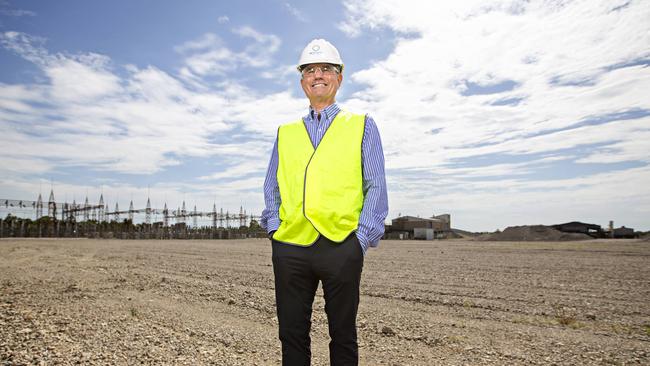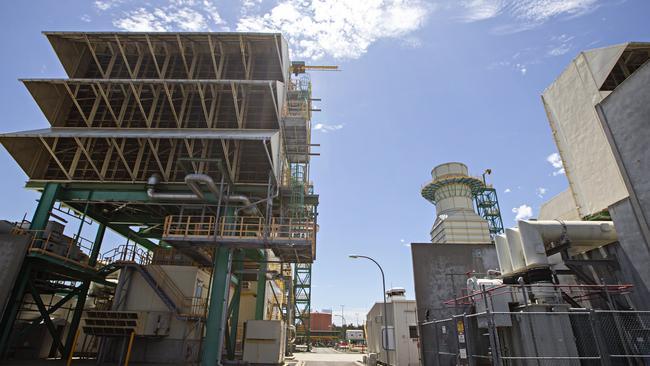Snowy Hydro boss eyes huge gas plant as coal closures approach
The architect of the federal government’s $5.1bn Snowy 2.0 expansion is now lining up to build Australia’s largest gas power plant.

Business
Don't miss out on the headlines from Business. Followed categories will be added to My News.
Snowy Hydro boss Paul Broad likes to think big. The architect of the federal government’s $5.1bn Snowy 2.0 expansion is now lining up to build Australia’s largest gas power plant to ensure the lights stay on when the Liddell coal station starts to close its doors at the end of 2022.
Just like its giant hydro expansion under way in the Snowy Mountains, the proposed NSW gas facility at Kurri Kurri near Newcastle has attracted its fair share of criticism from energy industry rivals who worry investment from the government-owned company will make it tougher to sanction their own projects.
But Broad is unapologetic and says Snowy is right to act now, making sure enough reliable generation is in place at low prices to back up the increasing penetration of solar and wind and the eventual exit of coal.
“As soon as the government gives us the tick that they think we’re going to go, we’ll do it,” Broad tells The Weekend Australian on a tour of the Kurri Kurri site. “Let’s stop talking about it and arguing the toss and doing desktop reviews. We need to get on with it, get some boots in the ground and make it happen.”
Broad, who lives nearby in Newcastle, has kept a close eye on the location ever since Norway’s Hydro shut its aluminium smelter at the site in 2014. Snowy already runs Colongra power station, the state’s largest gas-fired plant nearby on the Central Coast. But he says the Kurri Kurri plant, which could be even larger than Colongra, will also be required once the 1680MW Liddell shuts operations in the 2022-23 summer.
“We’ve been thinking about how we can raise our capacity because as Liddell retires and NSW puts more renewables in the system, we will also need reliable power at the other end to back it up,” Broad says.

The Snowy chief is used to dealing with doubters, with some market experts still worried about whether the business case stacks up for the huge 2.0 hydro expansion. Broad says Kurri Kurri might be at a smaller scale but has undergone a rigorous internal assessment along with financial analysis from the government’s advisers.
“We’re very committed as we were for 2.0 when people argued against us — we never deviated on 2.0 — and that is the same here. We’ve done the work for some time, not just in five minutes, and we’re very strong that this will stack up.”
At an estimated cost of around $600-700m, Snowy says the gas plant would deliver a rate of return topping 10 per cent. Still, if it does proceed it will likely require the government as its sole shareholder to tip in some funds to get the project over the line, given balance sheet pressures from the 2.0 project.
The gas plant has already courted some controversy. Scott Morrison shocked investors in late September after revealing Snowy was developing options to build the 750MW Kurri Kurri generator if private investors failed to step up and build new supplies before AGL Energy’s Liddell coal unit closes.
The government gave companies until April to commit to building 1000MW of new power capacity to ensure there was a like-for-like replacement for Liddell.
Rather than waiting around for a decision on those commitments, Broad and his Snowy team have been flat out working behind the scenes getting the gas project ready for a potential green light.
Snowy has completed a business case for Kurri Kurri along with early design and engineering works on repurposing the site, with a target of bringing supplies online by mid-2023, helped by existing electricity infrastructure already being in place at the industrial site.
Talks have been held with Jemena over accessing gas supplies from the Sydney-Newcastle pipeline and also with energy giant Santos over receiving output from its proposed Narrabri gas project. An option to buy gas turbines from suppliers in Europe is also progressing.
Critically, it is not reliant on any new gas project proceeding and can access enough capacity from the existing Sydney-Newcastle pipeline to prop up the project.
“We’re very bullish about being able to meet those tight timeframes. And the good thing about a gas plant is you can buy them off the shelf.”
Broad expects to hear from Canberra by mid-March over whether the plant will be needed and says Snowy’s board, chaired by former Santos boss David Knox, will convene in February and March to consider signing off on the project.
Still, the big unknown is whether private industry will meet the 1000MW target in less than three months’ time. EnergyAustralia will make a decision by March on its 300MW Tallawarra B gas plant while Origin Energy and Neoen are thinking even bigger with plans announced this week for the world’s biggest batteries.
AGL also remains in the frame with its 250MW Newcastle gas peaker but that appears more distant after the power giant blamed the NSW government’s new energy policy for a decision in November to defer the Newcastle facility, along with a giant battery at Liddell.
Broad thinks Tallawarra will likely get over the line along with several battery investments. However, he thinks that may still require Snowy to proceed with at least a 350MW gas plant at Kurri Kurri to ensure enough power is in place.
“The lead time for these things is not short and you’ve got to get yourselves organised. So if they get it over the line, good luck to them. But my sense is I don’t think they are all lined up and we are here as an insurance policy in the meantime.”
An added complexity swirls around the NSW government’s ambitious plan to attract $32bn in private investment over the next decade, focused on 12 gigawatts of renewable generation and 2GW of long-duration storage.
In addition to having its own Snowy Hydro option in the field, the federal government remains in talks with Origin, AGL and EnergyAustralia to determine whether their projects will stack up by the deadline and whether battery projects meet its criteria.
“The commonwealth’s 1000MW target is intended to deliver the reliable generation that NSW will need when Liddell closes,” a spokesman for Energy Minister Angus Taylor said.

Even if the 1000MW target is met, Snowy will hold on to the rights to develop Kurri Kurri, based on the company’s expectations a supply gap will open up later this decade.
Broad points to the way solar has undercut the role of coal in Australia’s energy mix, which could bring forward the retirement of nearby coal plants in the state, including Trevor St Baker’s Vales Point and Origin’s Eraring plant. Along with Kurri Kurri, Snowy would also consider the option of doubling Colongra’s capacity to balance up renewables.
“We believe Kurri Kurri will be needed by a 2027 timeframe given we may see these coal plants come out earlier than anticipated. So we’ll keep this and we’ll keep the option to double Colongra,” Broad says. “We’ll need an energy system that can be workable in a post-coal plant world, and gas will need to be right at the heart of that.”
More Coverage
Originally published as Snowy Hydro boss eyes huge gas plant as coal closures approach





